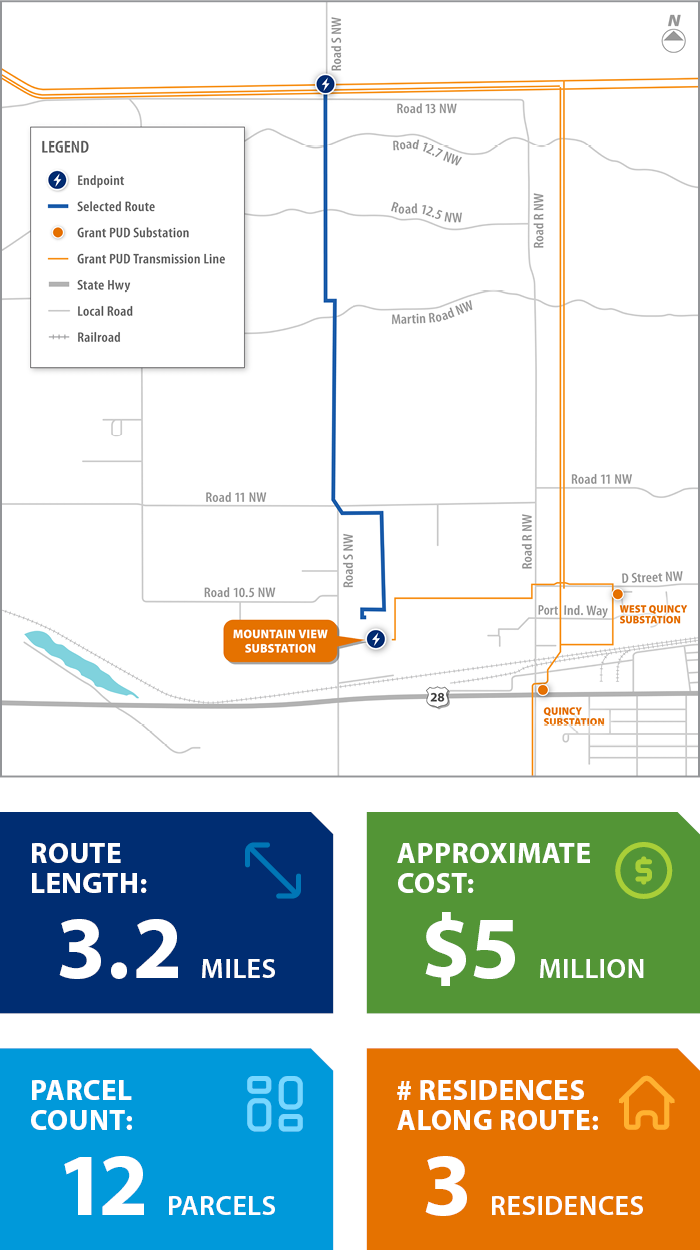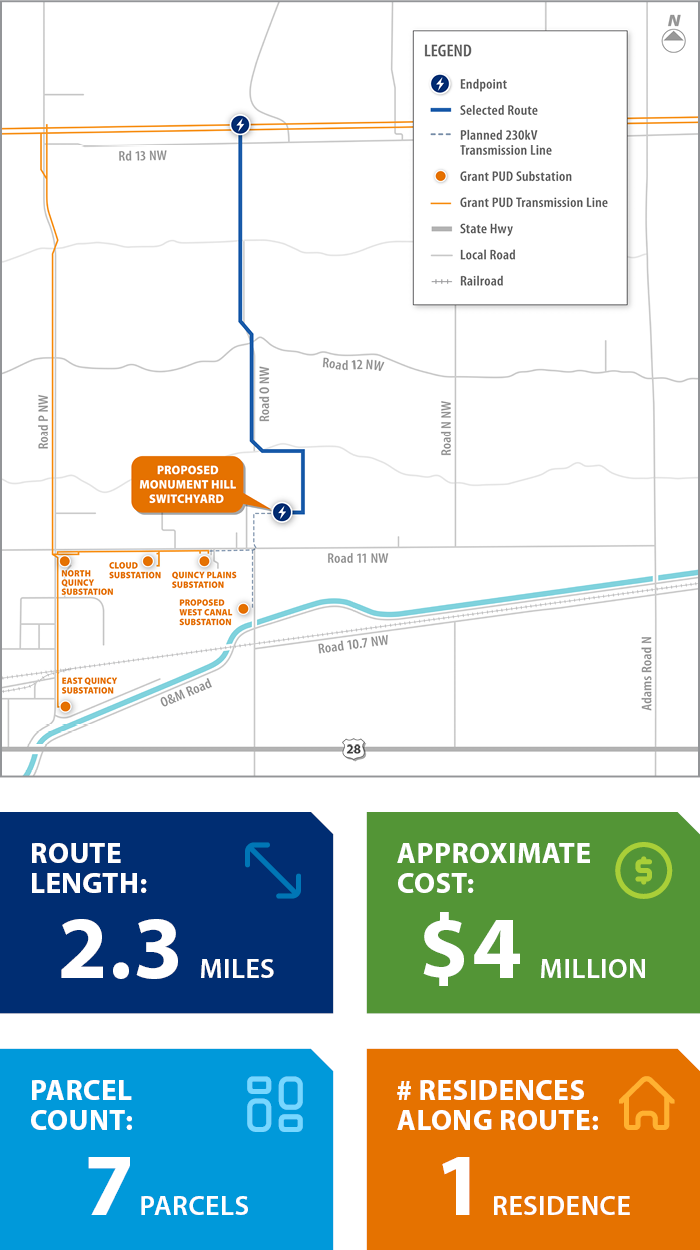Quincy Transmission Expansion Plan
Grant PUD’s Quincy Transmission Expansion Plan takes a proactive approach to managing the county’s power system. The plan includes projects that will increase electrical capacity in the Quincy area to meet future energy needs. Click the buttons in the graphic below to learn more about the projects.

- Columbia to Mountain View transmission line -
- Monument Hill to Rocky Ford transmission line -
- Monument Hill Loop #1 -
- Monument Hill switchyard -
32-mile transmission line from the Wanapum switchyard to the Mountain View substation in Quincy
Who do I contact for questions regarding the QTEP transmission routes?
Email your questions to:
Derek Mashburn, Transmission Engineer at: dmashburn@gcpud.org
Chris Johnson, Switchyard Engineer at: cjohnson@gcpud.org
Igor Shaporda, Lands Specialist at: ishapor@gcpud.org

Quincy 230kV Transmission Improvements Project
Overview:
Grant PUD is proposing to build three new transmission lines and a switchyard in Quincy. These projects will improve electrical capacity and resiliency in the Quincy area.
Columbia to Mountain View:
This new line would connect the existing Columbia to Rocky Ford 230kv transmission line to the existing Mountain View substation, located on the west side of Quincy and just north of SR 28.
Selected Route 2
Monument Hill to Rocky Ford:
This new line would connect the existing Columbia to Rocky Ford 230kV transmission line to a proposed Monument Hill switchyard northeast of the intersection of Road 11 NW and Road O NW.
Selected Route 2
Monument Hill Loop #1:
This new line will complete a 230kV transmission loop that will provide a second transmission source to existing and future substations in the east Quincy area. The line will begin and end at the Monument Hill switchyard and will improve reliability and maintenance flexibility.
Selected Route 1
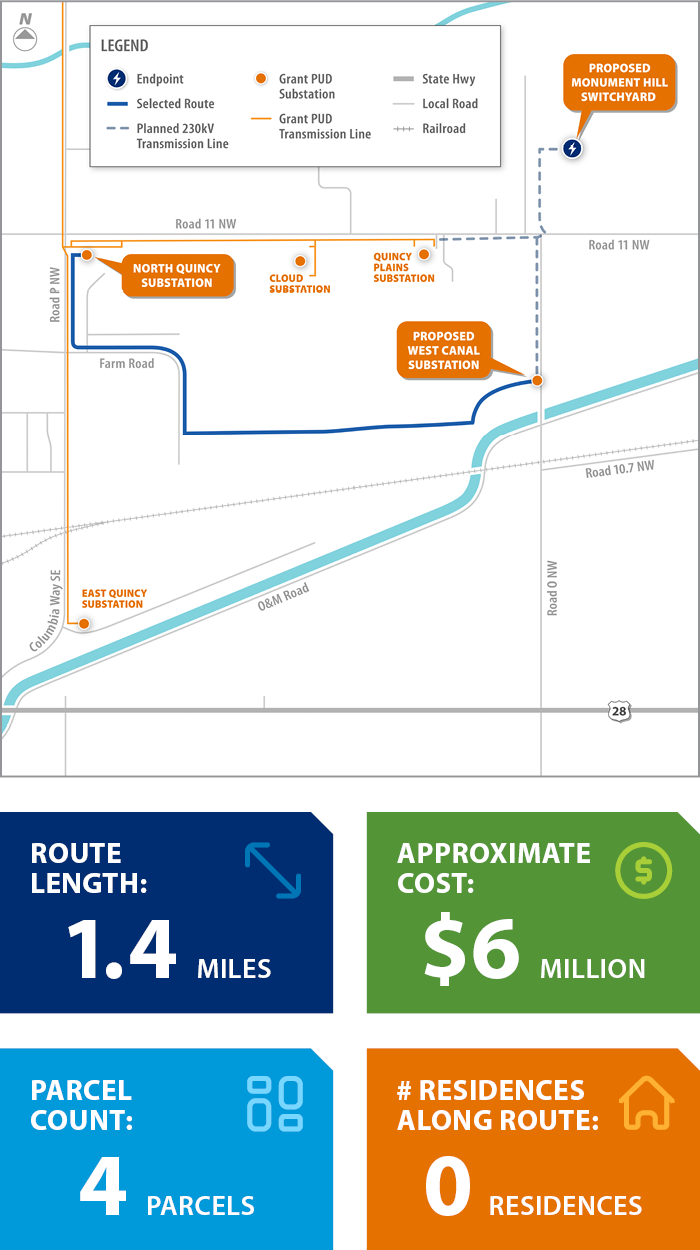
Study areas:
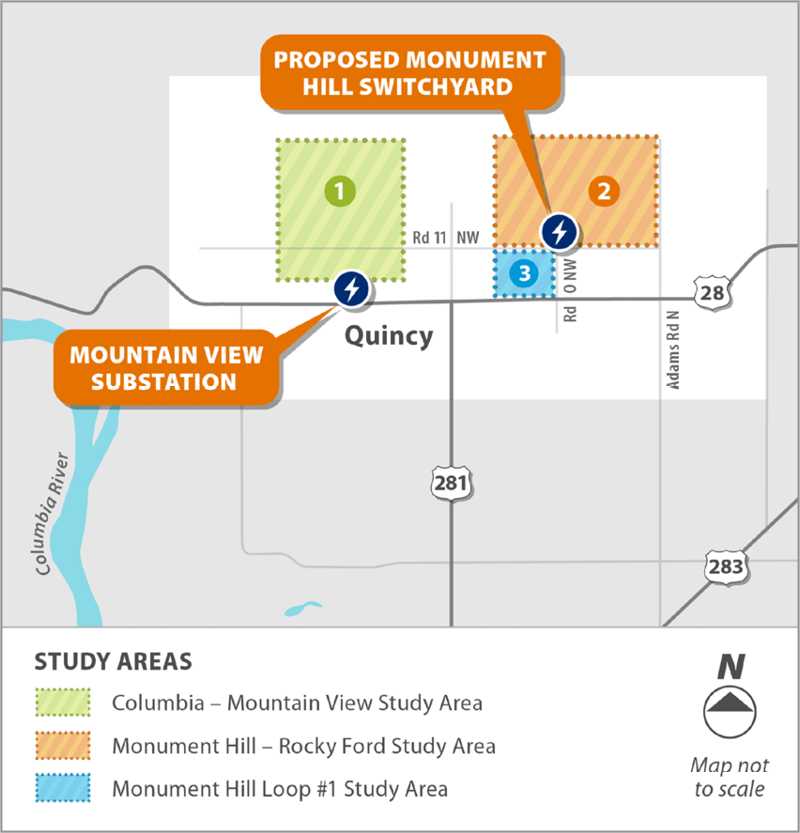
Need and community benefits:
To keep up with growing demands for electricity, Quincy’s power grid needs greater capacity and redundancy, with more connections to local power sources like the Wanapum Dam.
The Quincy Transmission Improvements Projects would add greater capacity and redundancy to the Quincy power grid. This allows us to continue providing reliable power to homes and businesses, even as demand grows. A more redundant system allows for maintenance activities and ensures the power stays on for businesses and homes during outages.
What’s happening now?
Grant PUD held public meetings in February 2022 to share route alternatives and asked for input from the community. Considering both community feedback and technical information, the recommended preferred routes were presented to the Grant PUD Board of Commissioners in June.
The project will now be advanced to further design, and environmental review of the selected routes under Washington’s State Environmental Policy Act.
Timeline:

Wanapum to Mountain View
Overview:
Grant PUD is proposing to build a 32-mile, 230kV transmission line from the Wanapum switchyard to the Mountain View substation in Quincy. This project will bring more electrical capacity to the Quincy area.
Selected Route Alternative 4b
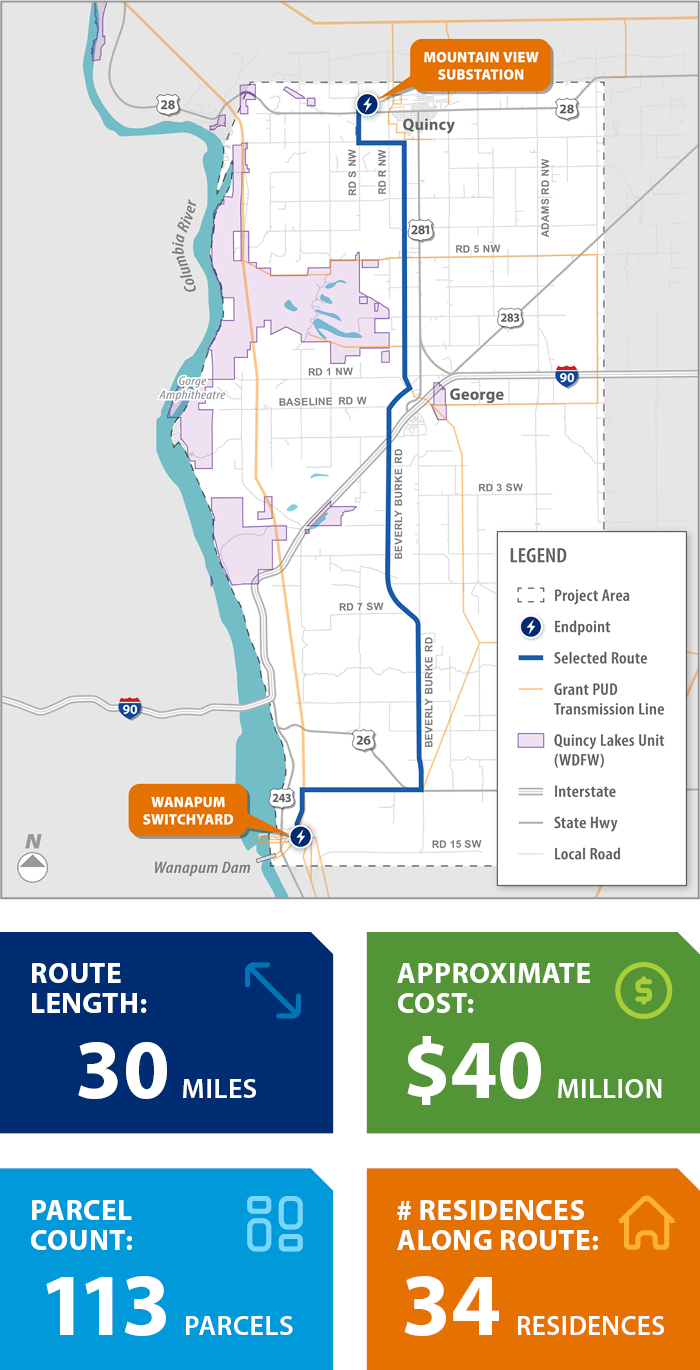
Need and community benefits:
To keep up with growing demands for electricity, Quincy’s power grid needs greater capacity, with more connections to local power sources like the Wanapum Dam. The new transmission line will provide that connection, increasing electrical capacity and helping Grant PUD continue to provide reliable power to homes and businesses as demand grows.
This project is part of Grant PUD’s larger Quincy Transmission Expansion Plan that takes a proactive approach to managing the county’s power system, increasing electrical capacity to meet future energy needs.
What's happening now?
At the October 25th Commission Meeting, the QTEP project team briefed the commission on the selection of Alternative 4b for the Wanapum-Mountain View Transmission Line Route. The materials from this meeting can be found on the Grant PUD website here. The project will now be advanced into further design, and environmental review of the selected route under the National Environmental Policy Act and Washington’s State Environmental Policy Act.
Timeline:
Frequently Asked Questions
Public Utility District #2 of Grant County’s (Grant PUD’s) Quincy Transmission Expansion Plan (QTEP) takes a proactive approach to managing the county’s power system. QTEP includes projects that will increase electrical capacity in the Quincy area to meet future energy needs.
QTEP consists of the following projects:
• Columbia – Mountain View 230kV Transmission Line
• Mountain View – Monument Hill 230kV Transmission Line
• Monument Hill – Rocky Ford 230V Transmission Line
• Wanapum – Mountain View 230kV Transmission Line
• Mountain View 230kV Loop #1 Transmission Line
• Monument Hill 230kV Loop #1 Transmission Line
• Monument Hill Switchyard
• Mountain View Substation Expansion
• Wanapum Switchyard Expansion
• Installation of Substation Capacitors
The purpose of the QTEP transmission line projects is to provide new path for energy to flow from Grant PUD’s Wanapum Switchyard and also provide operational flexibility for Grant PUD’s facilities in Quincy.
Grant PUD hosted two public open houses in Quincy (February 8 and 16, 2022) and one virtual open house (February 17, 2022) to present the Quincy Transmission Improvements projects. For the purposes of acquiring public input, the Quincy Transmission Improvements are a subset of the QTEP projects and include:
• Columbia – Mountain View 230kV Line
• Monument Hill – Rocky Ford 230V Line
• Monument Hill 230kV Loop #1
Also, to introduce the public to the Wanapum – Mountain View 230kV Transmission Line project, Grant PUD hosted one public open house in George, Washington (February 22, 2022), one public open house in Quincy (March 2, 2022), and one virtual open house (March 3, 2022).
Randy Kono, Electrical Engineer at: rkono@gcpud.org
QTEP is estimated to cost approximately $163 million.
The estimated construction costs for the Quincy 230-kV transmission projects are between $15 million and $23 million in combined costs for the three Quincy projects. The estimated construction costs for the Wanapum – Mountain View 230kV Transmission Line project are between $32 million to $37 million.
Transmission lines are key elements in the electrical system. These lines transport high-voltage electricity from power generation sources, such as Grant PUD’s Priest Rapids and Wanapum hydroelectric dams, to local substations in our communities.
Grant PUD is required to ensure that its transmission system can reliably serve customer power needs under all operating conditions, including during times of peak use (maximum demand). The proposed transmission lines will:
1. Provide capacity to deliver Grant PUD hydroelectric power to growing electrical loads (i.e., demand) in Quincy
2. Increase transmission system reliability
3. Improve performance of Quincy’s energy system
As part of the utility's Capital system, costs are recovered over time from retail rate revenue of our customers.
Grant PUD has initiated public outreach to inform the public on the selection of the preferred route for Wanapum to Mountain View transmission line.
Grant PUD plans to identify preferred routes the second quarter of 2022.
After permitting and right-of-way acquisition, Grant PUD anticipates beginning material procurement and construction of these projects as early as 2025.
Weathering Steel poles that extend above the ground from 80 feet to 120 feet will be used. Span lengths and topography of the land will dictate the heights of the poles.
Grant PUD has yet to propose the locations of the poles. During subsequent planning phases, Grant PUD will develop conceptual designs that will provide information such as proposed angle locations and the side of the road on which the lines could potentially be located for the preferred routes. The subsequent phases of the design process will determine the requirements for new or expansion of existing easements.
Underground transmission lines are extremely costly to build and repair. Underground lines can cost up to ten times as much to build as overhead transmission lines, depending on terrain, environmental constraints, and other factors, The environmental impact of digging trenches to bury cable can also be significant.
Additionally, the reliability of underground transmission lines is a major question across the United States, as relatively few have been constructed other than in dense, urban settings. A problem in a buried line would take much longer to locate and repair than a similar problem in an overhead line.
Grant PUD will negotiate directly with private property owners to acquire the necessary easements and rights-of-way. Experience shows that fair and reasonable agreements are reached after an appraisal process that takes into account the features of each particular property. It is in the interest of Grant PUD to make every effort to reach agreements quickly and fairly.
Land within the easement may be used for purposes that do not interfere with the operation, maintenance, or construction of the line. Some examples of appropriate land use, if wires to ground clearances remain acceptable, include using the land for cultivation or pasture in farming operations, or for streets, curbs, gutters and underground utilities in areas of potential development. The utility should be contacted before a change in use occurs to ensure compliance with the National Electric Safety Code (NESC). Some examples of inappropriate land use include the construction of buildings or the planting of tall trees in the easement area.
Except for emergency situations, a property owner can generally expect the line to be accessed once a year by Grant PUD. Maintenance will be conducted if issues are observed during the assessment. Maintenance may include pruning of trees that encroach in the right-of-way. In the event of an outage (emergency), the line could be accessed as line crews troubleshoot the root cause of the outage.
EMF, which are associated with transmission lines and substations, surround us every day. They are natural consequences of our use of electricity. These fields are produced by electric ranges, lights, motors, televisions, microwave ovens, hair dryers, and all other devices that use electricity. Numerous EMF studies have been conducted during the past 30 years to determine if exposure to EMF is harmful. More than 20 scientific review panels have analyzed this body of research and concluded that none of these studies has established a cause-and-effect relationship between EMF and any harmful health effects.
There are no federal/state regulations or NESC requirements specifically limiting exposure to electric and magnetic fields.
Grant PUD will be happy to provide scientific literature on EMF if requested.
GPS signal interference should not generally occur as a result of transmission lines. GPS devices continuously pull signals from multiple satellites—not just one. If farming equipment has a GPS unit, the equipment should work as properly when underneath a transmission line as it does when not near a transmission line. There is potential for a signal to be temporarily blocked, although the signal should come back within a few seconds as the farm equipment continues to move.
The Institute of Electronics Engineers (IEEE) previously published a white paper titled “Use of Global Positioning System (GPS) Receivers Under Power-Line Conductors,” which evaluated a similar question. The potential effects of electromagnetic interference and/or signal scattering from overhead conductors are evaluated analytically and with some practical measurements under transmission lines. Based on the analysis presented in the IEEE white paper, it is unlikely that power line conductors will interfere with use of the GPS satellite signals.
The effect of a transmission line project on property values can be significantly reduced or eliminated by setback distance, intervening landscaping, shielding of visual effects, and integration of the transmission line corridor into the neighborhood (trails, for example). Recent studies analyzing the effect of transmission lines on property values have concluded that transmission lines alone typically do not have a significant negative impact on property values.
The NESC is an industry standard that provides minimum line design requirements including probabilistic wind load cases. The District realizes that these are minimum requirements and has many years of experience within the area to design new lines in high-wind areas for structural capacity as well as wire blowout.
Generally, transmission lines do not cause interference with radio, television, or cellular phone signals. However, some potential interference sources do exist, including corona discharges, shadowing, and reflection.
Corona discharges occur when electric fields near an energized transmission line conductor produce small electrical discharges that ionize nearby air. The air ionization caused by corona discharges can result in the formation of audible noise and radio frequency noise. If the discharges are excessive, the audible noise can reach annoyance levels and the radio frequency noise can cause interference with radio and television reception. The potential for radio and television signal interference, however, is largely dependent on the magnitude of the corona-induced radio frequency noise relative to the strength of the broadcast signals.
Shadowing and reflection effects are typically associated with large structures, such as high buildings, that may cause reception problems by disturbing broadcast signals and leading to poor radio and television reception. Although the occurrence is rare, shadowing and reflection may occur if a transmission structure is placed between your receiver and a weak distant signal. Most reception is now digital, which allows for multiple paths to a signal and lower probability of signal interference.
Grant PUD receives an annual average of approximately 960 megawatts from Wanapum and Priest Rapids dams to serve the county’s demand for electricity. Our federal license to operate the dams allows for about 60% of those average megawatts to come from the dams’ physical output. The rest comes in financial form through long-term power-purchasing contracts with regional utilities. We currently use money from those contract sales to buy power from the wholesale market for our Grant County customers.
Grant PUD expects on a planning basis that by 2026 our county’s growing power needs will regularly exceed both the energy and financial benefits of our hydro projects.
Although we currently meet these expanding needs from wholesale power market purchases in the short term, we believe it is prudent to consider developing long-term contracts with wholesale power providers, and/or expanding our own power generation resources. That is why we are exploring nuclear power generated by “small modular reactors.” This promising, on-demand, carbon-free technology has the potential to help us achieve our mission of providing safe, efficient and reliable power for our customers.
To learn more about how we expect to meet power demands in the future, please see our latest Integrated Resource Plan, which is updated every two years. To learn more about why we are exploring small modular reactors see: www.grantpud.org/nuclear.
Grant PUD’s commissioners have determined that customers in the Residential, General Service (small business), Irrigation and Large General Service rate groups will be the first to enjoy the benefits of our hydropower resources. Customers in the other rate classes will also benefit from the same resources. However, under current policy, those in the Large Industrial rate class would pay incremental energy expenses through a cost-recovery process that is part of their existing rate.

